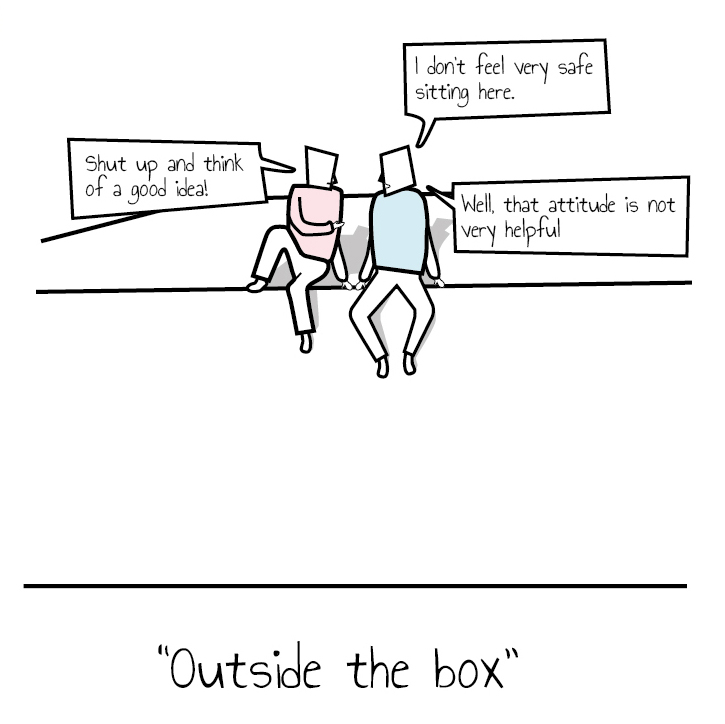
Coming up with an out of the box idea, Image Credit: Lukas Vegys
Creativity is a thorny issue as many people see themselves as inherently not creative. As we are working on a UX design course, this was precisely the topic we covered this week; what is creativity, and how can we strengthen our creative muscles?
Langley and Jones stated, “Humans possess no general creativity factor, so no such component exists to be measured. Instead, humans possess a wealth of knowledge structures indexed by concepts that person judges important. The level of creativity that a person exhibits will depend on his knowledge, his indexing scheme, and the particular situation in which he finds himself” (1986: 22). The implication is that people don’t have a creativity gene that they are born with or without, but that we all can be creative by drawing on our personal knowledge. However, memory cannot be relied upon alone; we must use a process of analytical thought to apply our memories to our current situation or problem to find a creative solution. By combining creative and analytical thought work for us, we can push our knowledge in innovative directions. Despite memory being a great help to our creativity, it can also hinder us by making our ideas travel well-worn paths (Runco and Chand 1995). Therefore, relying too much on our learned perceptions will stagnate innovation.
Humans are hardwired to employ redundancy. The American Psychological Association defines redundancy as “the property of having more structure than is minimally necessary” (2023). In this context, redundancy means if we know a solution or an idea was successful in the past, we will default to using the same solution for our problem today. Redundancy highlights the importance of knowing how to use our knowledge or perceptions appropriately and “how we access, manipulate, combine, and transform what we know in the service of creative goals.” (Silvia 2015: 604)
To promote a systematic approach to design, the British Design Council developed the Double Diamond technique in 2003; they aimed to identify methods which could be used within a framework to aid the design process (Ball 2019). The double diamond combines two different types of thinking, convergent (typically considered as a marker for intelligence) and divergent (typically considered as a marker for creativity) (Silvia 2015). Combining the two types of thought allows for the magical combination of analysis and free thinking to help avoid potential stagnation by disrupting our perceptions. However, following the Double Diamond format too rigorously could lead to problems by viewing design as a linear process. In my opinion, designers can avoid this problem by using the Double Diamond as an aid rather than a rigid structure.
I have never used much structure in my design process. However, after this brief introduction to the world of cognitive psychology, I have a very different view of the Double Diamond technique in particular. I knew of it previously and had always viewed it as another handy tool like mind mapping. Knowing that the Design Council combined intelligence and creativity as the bedrock of their process highlights that creativity or creative thinking is just another skill that anyone can learn with practice. That’s really all creativity is: looking at something from a different angle or in a different light.
Additionally, the convergence/divergence process adds so much more depth to creative output that I feel has been lacking from my previous design work. To that end, I plan to utilise the processes behind the Double Diamond technique and cement them in the foundation of my design practice. But as with every tool, it is still just a tool. It will be incredibly helpful, but it won’t guarantee success.
References
AMERICAN PSYCHOLOGICAL ASSOCIATION. 2023. ‘APA Dictionary of Psychology’. American Psychological Association [online]. Available at: https://dictionary.apa.org/ [accessed 29 Jan 2023].
BALL, Jonathan. 2019. ‘The Double Diamond: A Universally Accepted Depiction of the Design Process’. Design Council [online]. Available at: https://www.designcouncil.org.uk/our-work/news-opinion/double-diamond-universally-accepted-depiction-design-process/ [accessed 29 Jan 2023].
LANGLEY, Pat and Randolph JONES. 1986. ‘A Computational Model of Scientific Insight’. UC Irvine: Donald Bren School of Information and Computer Sciences [online]. Available at: https://escholarship.org/uc/item/54x8v354 [accessed 29 Jan 2023].
RUNCO, Mark A. and Ivonne CHAND. 1995. ‘Cognition and Creativity’. Educational Psychology Review 7(3), 243–67.
SILVIA, Paul J. 2015. ‘Intelligence and Creativity Are Pretty Similar After All’. Educational Psychology Review 27(4), 599–606.
German vocabulary of the week
Creative Goal – Kreatives Ziel
